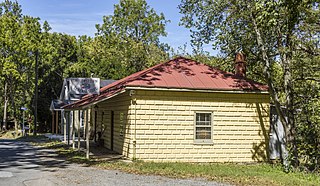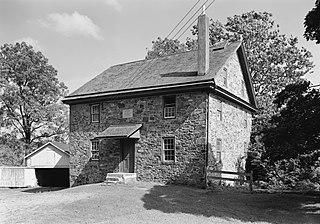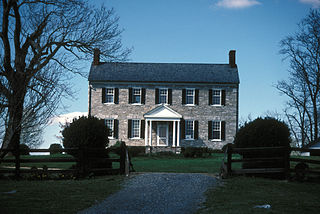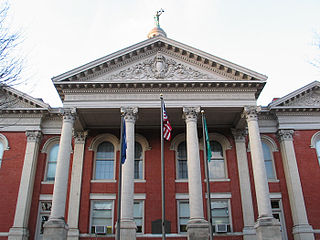
Friendship Hill was the home of early American politician and statesman Albert Gallatin (1761–1849). Gallatin was a U.S. Congressman, the longest-serving Secretary of the Treasury under two presidents, and ambassador to France and Great Britain. The house overlooks the Monongahela River near Point Marion, Pennsylvania, about 50 miles (80 km) south of Pittsburgh.

Buildings, sites, districts, and objects in Virginia listed on the National Register of Historic Places:

The Maggie L. Walker National Historic Site is a United States National Historic Landmark and a National Historic Site located at 110½ E. Leigh Street on "Quality Row" in the Jackson Ward neighborhood of Richmond, Virginia. The site was designated a U.S. National Historic Landmark in 1975. The National Historic Site was established in 1978 to tell the story of the life and work of Maggie L. Walker (1867-1934), the first woman to serve as president of a bank in the United States. It was built by George W. Boyd, father of physician, Sarah Garland Boyd Jones. The historic site protects the restored and originally furnished home of Walker. Tours of the home are offered by National Park Service rangers.
John Strother Pendleton, nicknamed "The Lone Star", was a nineteenth-century congressman, diplomat, lawyer and farmer from Virginia.

The Hillsboro Historic District in Hillsboro, Virginia is a historic district that was listed on the National Register of Historic Places in 1979. In 1979 it included 40 contributing buildings over its 60-acre (24 ha) area. Hillsboro was established as "The Gap", but in 1802 the town became Hillsborough. In 1880 the present spelling began to be used. Hillsboro is laid out in a roughly linear fashion along Virginia State Route 9, with lots in the historic district characteristically deep and relatively narrow. The pre-1835 houses in the district are characterized by two-story stone construction with gable roofs. Few new houses were built until the late 19th century, when Victorian houses were built, some with Eastlake detailing.

Rush-Miller House is a historic home located near Smoketown, Berkeley County, West Virginia. It is a two-story, "L"-shaped, stone dwelling with a gable roof. It is five bays wide and three bays deep. The rear ell was built about 1810 in the Federal style. The front two-story section was added about 1873. It is five bays wide and is of pounded rubble limestone in the Romanesque style. Also on the property is a stone bank barn (1909), stone and frame smoke house, and a stone springhouse.

Woodburn is a farm complex that was built beginning about 1777 for the Nixson family near Leesburg, Virginia. The first structure on the property was a stone gristmill, built by George Nixson, followed by a stone miller's residence in 1787, along with a stable. The large brick house was built between 1825 and 1850 by George Nixson's son or grandson George. The house became known as "Dr. Nixson's Folly." A large brick bank barn dates from this time, when Woodburn had become a plantation.

The Taylorstown Historic District comprises the historic core of Taylorstown, Virginia. The community and the historic district are centered on the Taylorstown Mill, a two-story stone structure on the banks of Catoctin Creek. Up the hill from the mill is Hunting Hill, a house built in 1737 for the mill's owner. The district also includes a store built in 1800, adjoined by the 1904 Mann's Store, with the 1900 Mann house across the street.

Rieser Mill is a historic grist mill and miller's house located in Bern Township, Berks County, Pennsylvania. The mill was built in 1825, and is a 2 1/2-story, rectangular stone banked building with a gable roof. The building replaced an earlier mill on the same site. The miller's house is a "T"-shaped, stone and brick dwelling. It was built in 1784, and enlarged in the late 1800s. The mill is located approximately 1/4-mile from the Rieser-Shoemaker Farm.

Spring Mill Complex, also known as the Michael Gunkle Spring Mill, is a historic grist mill complex located in East Whiteland Township, Chester County, Pennsylvania. The mill was built in 1793, and is a 2 1⁄2-story, banked stone structure with a gable roof. Also on the property are the contributing 2 1⁄2-story, stuccoed stone miller's house; a 1-story, stone spring house; a 1-story, stone smoke house; and a 1-story, stone carriage house. The mill remained in continuous operation into the 1940s.

Henry Miller House is a historic home located near Mossy Creek, Augusta County, Virginia. The original section was built about 1785, and expanded in the mid-19th century. It is a two-story, stone and brick dwelling with a combined gable and hipped roof. It consists of a square, four-bay, double-pile section with a three-bay, single-pile attached wing to form unbroken seven-bay facade. It features a full-width, one-story porch. Also on the property are a contributing two-story, one-cell rubble stone kitchen and two-story, three-bay, single-cell spring house.

Huntingdon, also known as The Meadow, is a historic plantation house located near Boyce, Clarke County, Virginia. The original section was built about 1830, and is a two-story, five bay, stone I-house dwelling with a gable roof. A rear ell was added around 1850, making a "T"-shaped house. Also on the property are a contributing pyramidal roofed mid-19th-century smokehouse and a stone-lined ice pit with a late 19th-century, square-notched log icehouse.

Woodlawn, also known as the Trible House, is a historic home located near Miller's Tavern, Essex County, Virginia. It was built about 1816-1820, and is a 1 1/2-story, two bay, frame dwelling with a gambrel roof. It features two exterior end chimneys constructed of brick. A lean-to addition was built about 1840.

Francis–Gulick Mill is a historic archaeological site located near Leesburg, Loudoun County, Virginia. The site includes a small stone miller's house foundation, stone remnants of a mill foundation, and the millrace and two millstones that are lying next to the miller's house foundations. The mill and miller's house may have been built as early as the late-18th century and were in use at least by the second decade of the 19th century. The mill appears to have been abandoned by 1879 and the house was abandoned in the 1880s.

Spring Bank, also known as Ravenscroft and Magnolia Grove, is a historic plantation house located near Lunenburg, Lunenburg County, Virginia. It was built about 1793, and is a five-part Palladian plan frame dwelling in the Late Georgian style. It is composed of a two-story, three-bay center block flanked by one-story, one-bay, hipped roof wings with one-story, one-bay shed-roofed wings at the ends. Also on the property are the contributing smokehouse, a log slave quarter, and frame tobacco barn, and the remains of late-18th or early-19th century dependencies, including a kitchen/laundry, ice house, spring house, and a dam. Also located on the property are a family cemetery and two other burial grounds. It was built by John Stark Ravenscroft (1772–1830), who became the first Bishop of the Episcopal Diocese of North Carolina, serving from 1823 to 1830.

Heiston–Strickler House, also known as the Old Stone House, is a historic home located near Luray, Page County, Virginia. It was built about 1790, and is a two-story, two bay, stone dwelling with a gable roof. It has a one-story late-19th century frame wing. It is considered one of the most handsome and best preserved of the Page County Germanic houses.

Stone House, also known as the Zachariah Johnson House, is a historic home located near Lexington, Rockbridge County, Virginia. It was built in 1797, and is a 2 1/2-story, five bay, stone dwelling. It has a side gable roof, interior end chimneys, and a central-hall-plan. The front facade features a rough-hewn, four columned portico with pediment.

Miller–Kite House, also known as Kite House, is a historic home located at Elkton, Rockingham County, Virginia. It was built in 1827, and is a two-story, five bay, "L"-shaped brick I-house dwelling. It has a cross-gable roof with eaves decorated with sawnwork filigree. It is traditionally believed to have been the headquarters of General Stonewall Jackson during the time that the renowned Valley Campaign was planned in April 1862. The house is a town landmark and museum operated by the Elkton Historical Society.

C. W. Miller House, also known as the Mary Baldwin College Music Building, is a historic home located on the campus of Mary Baldwin University at Staunton, Virginia. It was built in 1899-1900, and is a 2 1/2-story, three bay, brick and stone building in a Châteauesque / Romanesque Revival style. It features four decorated brick chimneys with elaborately corbelled caps, a one-story wraparound porch, and a three-story round tower at the corner of the house. The house was sold to Mary Baldwin College in 1941 and houses the music school.

























